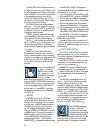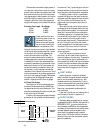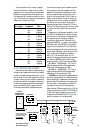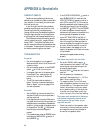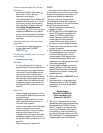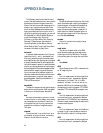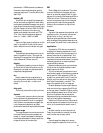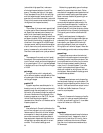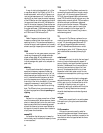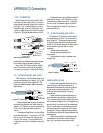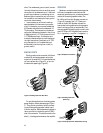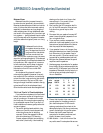28
APPENDIX B: Glossary
clipping
A cause of severe audio distortion that is the
result of excessive gain requiring the peaks of
the audio signal to rise above the capabilities
of the amplifier circuit. Seen on an oscillo-
scope, the audio peaks appear clipped off. To
avoid distortion, reduce the system gain in or
before the gain stage in which the clipping oc-
curs. See also headroom.
console
A term for a sound mixer, usually a large
desk-like mixer.
crest factor
The ratio of the peak value to the RMS
value. Musical signals can have peaks many
times higher than the RMS value. The larger
the transient peaks, the larger the crest factor.
dB
See decibel.
dBA
Sound Pressure Level (SPL) measured with
an “A” weighting filter.
dBm
A unit of measurement of audio signal level
in an electrical circuit, expressed in decibels
referenced to 1 milliwatt. The “m” in dBm
stands for “milliwatt.” In a circuit with an im-
pedance of 600 ohms, this reference (0 dBm)
corresponds to a signal voltage of 0.775 VRMS
(because 0.775 V across 600 ohms equals 1mw).
dBu
A unit of measurement of audio signal level
in an electrical circuit, expressed in decibels
referenced to 0.775 VRMS into any impedance.
Commonly used to describe signal levels within
a modern audio system.
dBv
A unit of measurement equal to the dBu but
no longer in use. It was too easy to confuse a
dBv with a dBV, to which it is not equivalent.
dBV
A unit of measurement of audio signal level
in an electrical circuit, expressed in decibels
This Glossary contains brief definitions of
many of the audio and electronic terms used in
discussions of sound mixing and recording.
Many of the terms have other meanings or nu-
ances or very rigorous technical definitions
which we have sidestepped here because we
figure you already have a lot on your mind. If
you’d like to get more information, you can call
Mix Bookshelf at 1-800-233-9604. We recom-
mend the following titles: The Audio
Dictionary, by Glenn White; Tech Terms, by
Peterson & Oppenheimer; Handbook for
Sound Engineers, by Glen Ballou; Mackie
Mixer Book by Rudy Trubitt; and Sound Rein-
forcement Handbook, by Gary Davis.
balanced
In a classic, balanced audio circuit, the two
legs of the circuit (+ and –) are isolated from
the circuit ground by exactly the same imped-
ance. Additionally, each leg may carry the signal
at exactly the same level but with opposite po-
larity with respect to ground. In some balanced
circuits, only one leg actually carries the signal,
but both legs exhibit the same impedance char-
acteristics with respect to ground. Balanced
input circuits can offer excellent rejection of
common-mode noise induced into the line and
also make proper (no ground loops) system
grounding easier. Usually terminated with
1
⁄
4
"
TRS or XLR connectors.
bandwidth
The band of frequencies that pass through a
device with a loss of less than 3 dB, expressed
in Hertz or in musical octaves. Also see Q.
bus
An electrical connection common to three
or more circuits. In mixer design, a bus usually
carries signals from a number of inputs to a
mixing amplifier, just like a city bus carries
people from a number of neighborhoods to
their jobs.
channel
A functional path in an audio circuit: an in-
put channel, an output channel, a recording
channel, the left channel, and so on.



